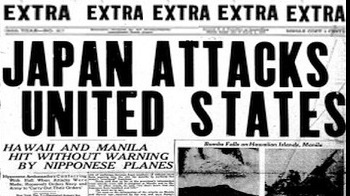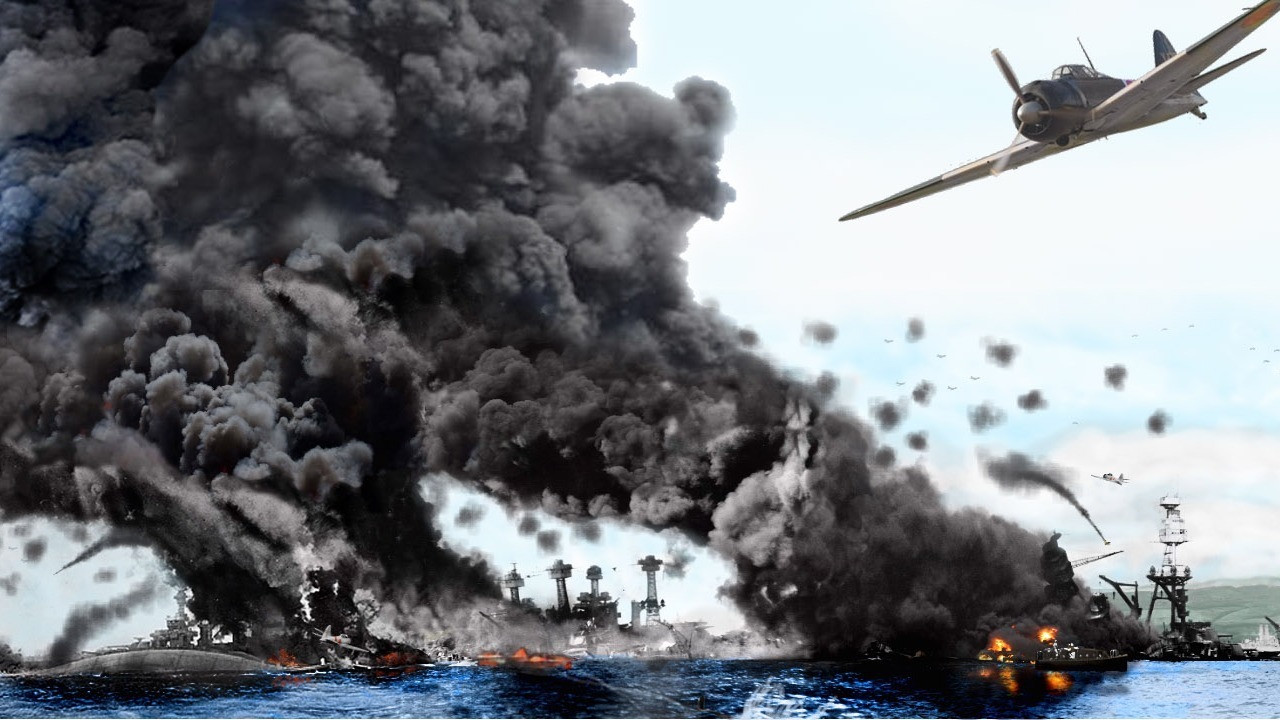Sunday morning, December 7, 1941
"I went downtown with my brother Norman and stepbrother, Hayward Thompson, to catch an early movie at the RKO Hill Street Theater at 8th and Hill Streets in Los Angeles.

"I am 16 years old, a senior at Polytechnic High School in Los Angeles, and I have no idea where Pearl Harbor is. I really didn’t understand that this is the beginning of a major war."
[The above is from the WWII journal kept by Ivan J. Houston, featured in the documentary film, With One Tied Hand, with portions published in the book by Mr. Houston and Gordon Cohn, "Black Warriors, The Buffalo Soldiers of World War II."]
[The following is edited from a history of Pearl Harbor by the Encyclopædia Britannica.]
In the 1930s, American foreign policy in the Pacific supported China support for China. In 1931 Japan took over the Chinese province of Manchuria, creating a new state called Manchukuo. A pitched battle between the Japanese and the United Front (Chinese Nationalists and the Chinese Communists) took place on the Marco Polo Bridge outside Beijing on July 7, 1937. In 1938, the United States government extended its first loan to China. And, in July 1939 the U.S. terminated the 1911 Treaty of Commerce and Navigation with Japan and began to restrict the export to Japan of war materials.
By July 1941, Japan had pushed aside the French Vichy government, occupied Indochina, and allied itself with the Axis powers (Germany and Italy). Of course, the U.S. government severed relations with Japan. When Germany invaded the Soviet Union, the Japanese knew there would be no attack from the West. The U.S. tried to negotiate with Japan but at the end of November, no agreement had been reached.
The U.S. Pacific Fleet comprised nearly 100 naval vessels, including 8 battleships and substantial military and air forces. As the tension mounted, Adm. Husband E. Kimmel and Lieut. Gen. Walter C. Short, who shared command at Pearl Harbor, were warned of the possibility of war, specifically on October 16 and again on November 24 and 27.
The notice of November 27, to Kimmel, began, “This dispatch is to be considered a war warning,” went on to say that “negotiations have ceased,” and directed the admiral to “execute an appropriate defensive deployment.” Kimmel also was ordered to “undertake such reconnaissance and other measures as you deem necessary.” The communication of the same day to Short declared that “hostile action is possible at any moment” and, like its naval counterpart, urged “measures of reconnaissance.”
In response to these warnings, the measures taken by the army and navy commanders were, as the event proved, far from adequate. Short ordered an alert against sabotage and concentrated most of his fighter planes at the base on Wheeler Field in an effort to prevent damage to them. He also gave orders to operate five of the mobile radar sets that had been set up in the island from 4:00 AM to 7:00 AM, considered to be the most dangerous period. (Radar training, however, was in a far-from-advanced stage.)

Kimmel, despite the fact that his intelligence had not been able to locate substantial elements in the Japanese fleet—especially the first-line ships in carrier divisions 1 and 2—did not expand his reconnaissance activities to the northwest, the logical point for an attack. He moored the entire fleet (save that part which was at sea) in the harbor and permitted a part of his personnel to go on shore leave. Neither of these officers suspected that the base at Pearl Harbor would itself be subjected to attack. Nor, for that matter, is there any indication that their superiors in Washington were in any way conscious of the approaching danger. In the 10 days between the war warning of November 27 and the Japanese attack itself, no additional action was taken by Washington.
Early on Sunday morning, December 7, Washington learned that the Japanese ambassadors had been instructed to ask for an interview with the secretary of state at 1:00 PM (7:30 AM Pearl Harbor time). This was a clear indication that war was at hand. The message took some time to decode, and it was not in the hands of the chief of naval operations until about 10:30. It was delivered to the War Department between 9:00 and 10:00 AM. Gen. George C. Marshall, the U.S. Army chief of staff, was out horseback riding and did not see the dispatch until he arrived at his office about 11:15 AM. The chief of naval operations, Adm. Harold Stark, even then did not think that the communication called for any additional instructions to Kimmel.
However, Marshall sent a new warning and gave orders to the military command to communicate with the navy. He did not telephone, fearing interception, and instead sent his dispatch by telegram. There was a mix-up in communication, however, and the warning did not reach Hawaii until after the attack had begun. It is important to note that it had not been filed until noon, only an hour before the Japanese planes moved in on the base.
At Pearl Harbor itself, there were incidents that, properly interpreted, might have given a brief warning. Four hours before the decisive moment, a Japanese submarine was sighted by the minesweeper USS Condor. About two and a half hours later, the commander of the destroyer USS Ward sent a message saying that he “had attacked, fired upon, and dropped depth charges upon submarine operating in defensive sea area” near Pearl Harbor. While Kimmel waited for confirmation of this report, the Japanese opened hostilities. In these same morning hours, U.S. Army Pvt. George Elliott, practicing on the radar set after its normal closing time, noticed a large flight of planes on the screen. When he telephoned his lieutenant, he was told to disregard the observation, as a flight of B-17 bombers from the United States was expected at that time. Once again, an opportunity was missed.
[Thank you for reading. Please watch for our next post.]
 Add Row
Add Row  Add
Add 




Write A Comment